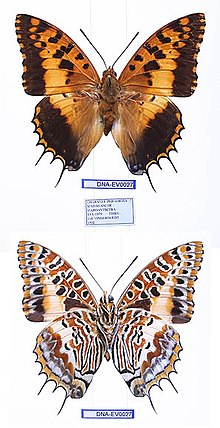Charaxes phraortes is a butterfly in the family Nymphalidae. It is found in north-eastern Madagascar.[3] The habitat consists of wet coastal forests.
| Charaxes phraortes | |
|---|---|

| |
| Scientific classification | |
| Domain: | Eukaryota |
| Kingdom: | Animalia |
| Phylum: | Arthropoda |
| Class: | Insecta |
| Order: | Lepidoptera |
| Family: | Nymphalidae |
| Subfamily: | Charaxinae |
| Tribe: | Charaxini |
| Genus: | Charaxes |
| Species: | C. phraortes
|
| Binomial name | |
| Charaxes phraortes | |
Description
editSimilar to pollux and phoebus, but has the tails on the hindwing much longer,8—9 mm. in length; the basal part of the upper surface is light red-brown and but little darker than the broad orange-brown median band; the cell of the forewing with two large black spots and the median band with large black spots in cellules 2—4; the hindwing above at the distal margin with orange-yellow transverse spots in 2—7; the hindwing beneath, with three black, white-bordered transverse spots at the costal margin in cellule 8;the ground-colour of the basal part bright red-brown. Madagascar; rare. [4]
Related species
editHistorical attempts to assemble a cluster of presumably related species into a "Charaxes jasius Group" have not been wholly convincing. More recent taxonomic revision,[5] corroborated by phylogenetic research, allow a more rational grouping congruent with cladistic relationships. Within a well-populated clade of 27 related species sharing a common ancestor approximately 16 mya during the Miocene,[6] 26 are now considered together as The jasius Group.[5] One of the two lineages within this clade forms a robust monophyletic group of seven species sharing a common ancestor approximately 2-3 mya, i.e. during the Pliocene,[6] and are considered as the jasius subgroup.[5] The second lineage leads to 19 other species within the Jasius group, which are split into three well-populated subgroups of closely related species.
The jasius Group (26 Species):[5]
Clade 1: jasius subgroup (7 species)
Clade 2: contains the well-populated three additional subgroups (19 species) of the jasius Group: called the brutus, pollux, and eudoxus subgroups.[5]
- the eudoxus subgroup (11 species):
- Charaxes eudoxus
- Charaxes lucyae
- Charaxes richelmanni
- Charaxes musakensis
- Charaxes biokensis[stat.rev.2005][5]
- Charaxes ducarmei
- Charaxes druceanus
- Charaxes tectonis
- Charaxes phraortes
- Charaxes andranodorus
- Charaxes andrefana[stat.rev.2025][5]
Further exploration of the phylogenetic relationships amongst existing Charaxes taxa is required to improve clarity.
References
edit- ^ Doubleday, E. 1847 [June]. On some undescribed species of Lepidoptera in the Society’s collection. Proceedings of the Zoological Society of London 1847: 58-61. [Reprinted in the Annals and Magazine of Natural History (1) 20: 63-66 [July]].
- ^ "Charaxes Ochsenheimer, 1816" at Markku Savela's Lepidoptera and Some Other Life Forms
- ^ "Afrotropical Butterflies: File H - Charaxinae - Tribe Charaxini". Archived from the original on 2013-11-09. Retrieved 2012-05-23.
- ^ Aurivillius, [P.O.]C. 1908-1924. In: Seitz, A. Die Großschmetterlinge der Erde Band 13: Abt. 2, Die exotischen Großschmetterlinge, Die afrikanischen Tagfalter, 1925, 613 Seiten, 80 Tafeln (The Macrolepidoptera of the World 13).Alfred Kernen Verlag, Stuttgart. This article incorporates text from this source, which is in the public domain.
- ^ a b c d e f g Turlin, B. (2005). Bauer & Frankenbach (ed.). Butterflies of the World: Charaxes 1. Vol. 22. Keltern: Goecke & Evers. pp. 2–3. ISBN 3937783156.
- ^ a b "Out of Africa again: A phylogenetic hypothesis of the genus Charaxes (Lepidoptera: Nymphalidae) based on five gene regions" Archived 2019-07-25 at the Wayback Machine. Aduse-Poku, Vingerhoedt, Wahlberg. Molecular Phylogenetics and Evolution (2009) 53;463–478
- Victor Gurney Logan Van Someren, 1974 Revisional notes on African Charaxes (Lepidoptera: Nymphalidae). Part IX. Bulletin of the British Museum of Natural History (Entomology) 29 (8):415-487. [1]
External links
edit